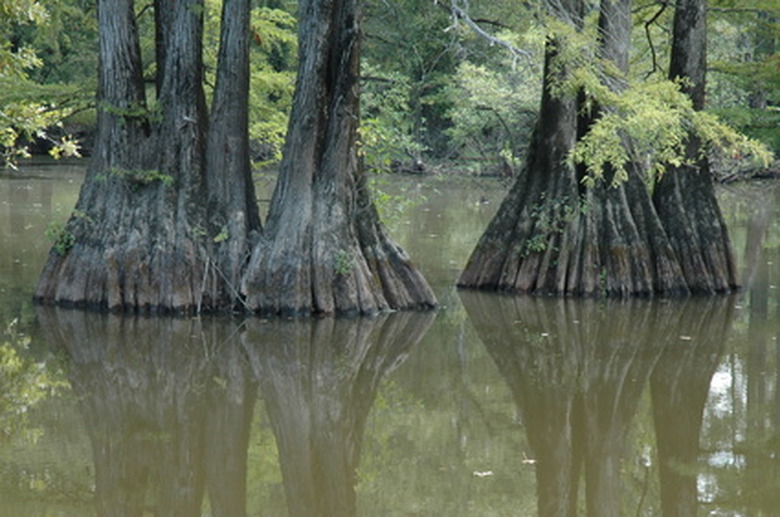Plants Found In Freshwater Swamps
Freshwater swamps are wooded wetlands. They have standing water for part or all of the year, according to the South Florida Information Access website. Some freshwater swamps also experience a dry season. Plants common in the swamps include cypress and other trees, vines, ferns and the "air plants," or epiphytes, that grow on them. Fire, temperature extremes, water levels and the amount of organic material in the soil all determine which plants grow in a specific freshwater swamp.
Baldcypress
Valued for its remarkably decay-resistant wood, baldcypress (Taxodium distichum) is a common sight in freshwater swamps across the Southern United States. Standing from 50 to 75 feet high, it has feathery, sage green leaves and peeling, silvery or reddish bark. Often living more than 600 years, aged bald cypress trees have spreading, flat canopies frequently festooned with Spanish moss.
- Freshwater swamps are wooded wetlands.
- Plants common in the swamps include cypress and other trees, vines, ferns and the "air plants," or epiphytes, that grow on them.
Trees constantly submerged in water develop shallow, conical root projections called "knees," according to the University of Florida School of Forest Resources and Conservation. Baldcypress seeds feed migrating Canada geese, rabbits and ducks. They also shelter white-tailed deer. Baldcypress grows best in full sun to partial shade. It needs moist or wet, acidic (pH below 6.8) sandy or loamy soil.
Crinum Lily
Like baldcypress, crinum or swamp lily is native to freshwater swamps across the South. This clumping perennial has a sturdy, 2- to 3-foot stem and long, narrow green leaves. Between June and November, swamp lily brightens its surroundings with showy clusters of fragrant white blooms. Sometimes tinged with pink, the flowers have outer petals that curve backward to create a spherical bloom. The blossoms may reach up to 4 inches across, according to the Lady Bird Johnson Wildflower Center. Crinum lily blooms in sun or shade. It needs fertile, wet acidic soil but isn't fussy about soil type.
- Trees constantly submerged in water develop shallow, conical root projections called "knees," according to the University of Florida School of Forest Resources and Conservation.
- Between June and November, swamp lily brightens its surroundings with showy clusters of fragrant white blooms.
Cinnamon Fern
Cinnamon fern (Osmunda cinnamomea) grows in freshwater swamps from New England and Minnesota south to Florida and west to Texas. Shallow-rooted, it sometimes grows 6 feet tall. Its downy fiddleheads–baby fronds–are silver when they emerge. Becoming more rigid and upright as they mature, the fruit-bearing, fertile fronds change from green to cinnamon. The plant also has a circle of sterile fronds surrounding the fertile ones, according to the Lady Bird Johnson Wildflower Center. The combination of cinnamon-colored inner and green outer fronds makes this an attractive landscape plant. Cinnamon fern handles full sun only if it is in standing water. Otherwise it needs partial to deep shade and moist to wet, acidic soil.
- Cinnamon fern (Osmunda cinnamomea) grows in freshwater swamps from New England and Minnesota south to Florida and west to Texas.
- The combination of cinnamon-colored inner and green outer fronds makes this an attractive landscape plant.
References
- South Florida Information Access Virtual Tour: Ecosystems:
- University of Florida School of Forest Resources and Conservation: Baldcypress
- Lady Bird Johnson Wildflower Center: Crinum Lily
- Lady Bird Johnson Wildflower Center: Cinnamon Fern
- University of Florida School of Forest Resources and Conservation: Swamp Plant Table
